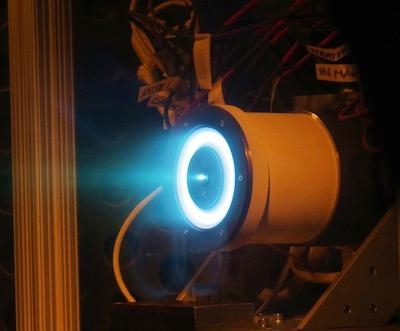Mon, May 13, 2019
Will Develop Low-Power Magnetically Shielded Hall Thruster For The Agency
Apollo Fusion has been awarded an exclusive, worldwide commercial license to NASA Jet Propulsion Laboratory's (JPL) MaSMi (Magnetically Shielded Miniature) Hall thruster, the world's first low-power (≤1.0 kW) magnetically shielded Hall thruster. MaSMi has demonstrated class-leading performance with a peak total efficiency of 54%, a peak total specific impulse of 1940 s, and an estimated throughput capability of >330 pounds Xe. MaSMi is a key component of JPL's ASTRAEUS (Ascendant Sub-kW Transcelestial Electric Propulsion System), a low-power electric propulsion (EP) system optimized for use on smallsats. In support of ASTRAEUS, Apollo was awarded a contract to manufacture three engineering model MaSMi-EM thrusters for JPL this summer.

Apollo is also designing a commercial version of this thruster called AXE (Apollo Xenon Engine) following an internal design-for-manufacturing process. The design-for-manufacturing improvements will enable AXE to be rapidly mass-manufactured for large constellation customers.
"We're absolutely thrilled to be working with NASA JPL and with Dr. Ryan Conversano, the PI of ASTRAEUS and the inventor of MaSMi. The MaSMi thruster that we now have the exclusive license for can produce more than 2,000,000 N-s of total impulse and yet is about the size of a soda can," said Apollo CEO Mike Cassidy. "We've heard many times that our propulsion system's high performance coupled with our rapid, high-volume manufacturing is enabling new space missions and constellations. This new relationship with NASA JPL further demonstrates that Apollo can deliver for these new constellations."
In addition to the NASA JPL thruster that Apollo has licensed, the smaller Apollo Constellation Engine (ACE) provides outstanding performance at only 400 watts: 24 mN of thrust, 200,000 kN-s of total impulse, 10 pounds of dry mass. This is about three times the total impulse per unit mass of any competitive propulsion system and about three times the total impulse per unit volume of any competitive propulsion system on the market today (for 110 to 1,100-pound smallsats).
(Image provided with Apollo Fusion news release)
More News
He Attempted To Restart The Engine Three Times. On The Third Restart Attempt, He Noticed That Flames Were Coming Out From The Right Wing Near The Fuel Cap Analysis: The pilot repor>[...]
Make Sure You NEVER Miss A New Story From Aero-News Network Do you ever feel like you never see posts from a certain person or page on Facebook or Instagram? Here’s how you c>[...]
From 2009 (YouTube Edition): Leading Air Show Performers Give Their Best Advice for Newcomers On December 6th through December 9th, the Paris Las Vegas Hotel hosted over 1,500 air >[...]
Aero Linx: NASA ASRS ASRS captures confidential reports, analyzes the resulting aviation safety data, and disseminates vital information to the aviation community. The ASRS is an i>[...]
“For our inaugural Pylon Racing Seminar in Roswell, we were thrilled to certify 60 pilots across our six closed-course pylon race classes. Not only did this year’s PRS >[...]
 NTSB Final Report: Rutan Long-EZ
NTSB Final Report: Rutan Long-EZ ANN FAQ: Turn On Post Notifications
ANN FAQ: Turn On Post Notifications Classic Aero-TV: ICAS Perspectives - Advice for New Air Show Performers
Classic Aero-TV: ICAS Perspectives - Advice for New Air Show Performers ANN's Daily Aero-Linx (06.28.25)
ANN's Daily Aero-Linx (06.28.25) Aero-News: Quote of the Day (06.28.25)
Aero-News: Quote of the Day (06.28.25)



